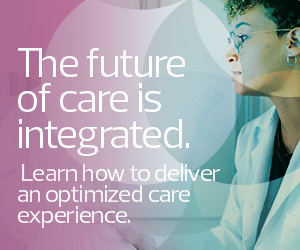Clinical Automation and Patient Room ‘Next’ Improve Care Delivery
Patient Room ‘Next’ is a strategy that supports clinicians by automating patient care. It explores the next iteration of technology for patient care in five categories: machine vision, machine audio, content interaction with patients, sensors and telehealth. The solutions come together to provide real-time insight into a patient’s current health status and vitals in a more touchless way.
Using this strategy, sensors and cameras can monitor patients for changes. These technologies are integrated into one platform that can then notify a physician or nurse, rather than a clinician having to deal with multiple alerts from different sources. By consolidating alerts into one location, a clinician has a clearer picture of a patient’s health and, as a result, the platform augments clinical decision-making.
Under this strategy, the patient room can refer to anywhere care is delivered, which extends the continuum of care beyond the traditional brick-and-mortar healthcare visit. The “next” part of the strategy refers to what’s next in patient care. As technology advances, there will be further iterations of Patient Room ‘Next’ to improve clinical efficiencies and patient care and experiences. We’re continuing to look to the future while working to solve today’s problems.
Overcoming Challenges to Clinical Automation Implementation
Implementation challenges aren’t usually related to a technology problem but instead a cultural or financial problem. In some cases, healthcare organizations have given nurses and doctors so many solutions to improve their workflow that they end up doing more harm than good. As a result, clinicians often don’t want to have to learn another technology. How do we get them to see that what we’re trying to do really is good for them and their workflow?
The idea that one set of technology and one platform can handle several tasks and continue to evolve over time to meet future needs is foreign to a lot of organizations that are used to point solutions. However, with Patient Room ‘Next’ and its variety of solutions, health IT and clinical leaders can continue to build on the platform. That’s why health IT leaders should choose platforms rather than single-point solutions.
Clinicians aren’t conditioned to think about solving future problems one or two years out. They’re used to trying to solve the problem in front of them. Patient Room ‘Next’ focuses on taking care of multiple problems at once in as few steps as possible. It requires someone to sit back and think about these problems from a big-picture perspective. A culture change may be needed to create that mindset.
READ MORE: Learn how health systems are updating patient rooms to improve experiences.
A lot of people focus on innovation, but it should really be transformation. It’s important to bring in the technology that’s there, change some processes and workflows, and transform the way healthcare is being done today, rather than pushing innovative technologies that may not transform workflows and care in the way an organization wants.
When assessing which problem to focus on, choose the one that clinicians and executives can support and that will garner financial backing. Everyone will be happier if they all easily recognize the problem and know how to fix it, and you won’t have to sell the platform solution. You want to choose a platform that can do more than what you bought it to do.
Implementing several point solutions can impede interoperability and create workflow inefficiencies. Having one platform sets the organization up for success in achieving interoperability. Remember that everything still needs to connect back to the electronic health record. Clinical automation changes how data is collected. Ensuring that the platform moves the data where it needs to go without any duplication is critical, or you risk creating additional workflow problems. With a Patient Room ‘Next’ strategy and a single platform, interoperability and integration among all of the technology solutions used becomes easier, but it still needs to be considered from the outset.













